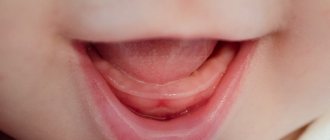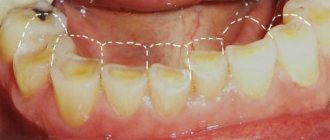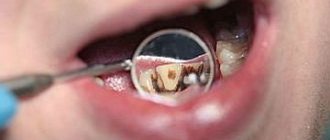Symptoms Causes Diagnosis During pregnancy Treatment methods Help with severe pain Help with severe pain Prevention
Unfortunately, due to many reasons, such health problems occur that teeth simply crumble. This can occur at different ages, with baby teeth in children and permanent teeth in adults. What to do? Of course, you should see a doctor. Go to the dentist, and after the examination he can refer you to a specialist and advise you to undergo an examination.
Symptoms
It is difficult to miss such a fact when a tooth has crumbled. This usually occurs while eating, and a hard piece of enamel is felt in the mouth. Sometimes there are many small pieces at once. There is a feeling of panic. After all, we know from school that enamel is the hardest tissue in the body. Why does this happen, causing teeth to crumble and crack?
It happens that it all starts with stains on the enamel - this is a symptom that not everything is in order. And you need to make a visit to the dentist before the crown of the tooth collapses.
What is caries?
From Latin, the word “caries” is translated as “rotting.” With caries, calcium is slowly, gradually and almost inevitably washed out of the tooth enamel, as a result of which the enamel is destroyed. Then the organic base of the tooth suffers, cavities form in it, followed by inflammation of the pulp (the internal tissue of the tooth that supplies it with blood vessels and nerve fibers) and periodontium (the connective tissue that holds the tooth). The reasons for the occurrence and development of this disease are complex. The general condition of the body, lifestyle, and the state of the environment all play a role.
Reasons why teeth may crumble
The answer to the question of why teeth crumble in an adult or child can be not only in the field of dentistry, but also much deeper, and everything is reflected in the condition of the dentition.
Causes:
- poor
oral hygiene. And no matter how they say that everyone always talks about the importance of the procedure, it is so. An acidic environment has a destructive effect on enamel, making it fragile and vulnerable. Increased acidity is affected by plaque on the teeth, which is where bacteria and their waste products—destructive acid—accumulate; - untreated caries
and other diseases, when there is a lot of carious tissue and the walls of the tooth become thinner. As a result, the tooth began to crumble; - mechanical causes
: trauma, super-hard food - nuts, chewing candy, etc., bad habits - chewing pencils, objects, opening a bottle with your teeth. As a result, the tooth cracked and broke; - changes in
food temperature. Very hot suddenly gives way to cold. The enamel does not withstand, cracks appear; - lack of vitamins
and minerals: calcium, vitamin D (which promotes the absorption of calcium), fluorine, phosphorus; - metabolic disease
. It is worth visiting an endocrinologist; - hormonal imbalance
. These are not only diseases associated with hormonal levels and fluctuations, but also special periods in a person’s life - adolescence and old age, menopause, pregnancy; - heredity
. Genetic predisposition to weak enamel; - stress
; - malocclusion
- uneven load on the lower and upper teeth; - Bruxism
is involuntary grinding of teeth during the day or at night.
Video from our expert about how and why teeth decay:
Teeth quickly decay due to chronic diseases, diseases of the gastrointestinal tract and endocrine glands. And crumbling teeth is a signal that needs to be responded to urgently.
Dental fluorosis: treatment and prevention
Diagnosis is carried out at a dentist's appointment. Only a specialist will be able to distinguish the manifestations of fluorosis from a chalk spot, which is the initial stage of a carious lesion. An important distinguishing feature is that fluorous spots are multiple in nature and affect permanent teeth almost immediately after eruption. While initial caries in the spot stage is observed on single teeth.
Treatment is selected individually and depends on how severely damaged the enamel is. At the initial stage of the disease, it is recommended to conduct a course of professional whitening followed by strengthening the enamel using remineralization.
In this case, bleaching is carried out with a gentle composition based on inorganic acids. The number of procedures is selected by the doctor. Usually at least 10 sessions. During the whitening period, it is recommended to take calcium supplements. The result lasts for 6–8 months, then a second course of professional cleaning and bleaching is required.
The remineralization procedure helps strengthen the enamel structure, saturating it with minerals. Calcium and phosphorus compounds penetrate dentin and restore enamel from the inside. This procedure is carried out in several ways:
- Applications with a special composition.
- Electrophoresis or phonophoresis.
- Wearing mouth guards in which active gel is applied.
On average, at least 15 procedures are prescribed. Before the procedure, complete sanitation of the oral cavity is mandatory.
If the disease has already spread to the dentin, then simply bleaching will be ineffective. For moderate severity of fluorosis, methods of aesthetic tooth restoration are used:
- installation of ceramic veneers;
- restoration of tooth shape and color using crowns.
Such methods are recommended not only for aesthetic purposes, but also for medicinal purposes. They help stop further tooth decay and reduce enamel sensitivity.
Home care is also important - using fluoride-containing toothpastes, taking vitamin and mineral complexes, reducing the intake of fluoride from water and food.
How to prevent the disease from developing
The main preventive measure to combat fluorosis is to control the amount of fluoride in drinking water, as well as in the air. Such measures are especially important for areas where the amount of fluoride in the population’s water supply has been found to exceed the norms. Such events are held at the state level.
On an individual basis, it is recommended to use purchased purified water for drinking or use tap filters for additional purification. At the same time, it is important to engage in prevention from the moment the child is conceived. A pregnant woman should be especially careful when choosing food and drinking water. Additional intake of vitamins C, D, and calcium gluconate can reduce the risk of fluorosis several times, especially in children.
When a baby is born, it is recommended to feed him breast milk for as long as possible. After introducing complementary foods, use juices or dairy products instead of water, if possible. If you live permanently in an endemic area, you need to take your children to other areas every year for health improvement. Replacing the water source for 3-4 months helps strengthen tooth enamel and stop the development of the disease.
An important point in disease prevention is nutrition. Limit or completely eliminate products containing fluoride. These are sea fish, nuts, spinach, seaweed. You need to eat more fresh vegetables or fruits.
Also, after consulting a doctor, you can use medicinal remineralizing toothpastes or applications at home.
Teeth began to crumble during pregnancy
For the development of the fetus, calcium is necessary, which the child receives from the body of the expectant mother. A woman experiences a deficiency if she does not eat well and does not take it additionally in the form of supplements or mineral complexes. Teeth may be destroyed, which occurs quite often in this “interesting position.”
The next factor influencing the weakness of dental tissue may be a hormonal surge during pregnancy and the nervousness of the mother.
Necessary:
- take care of a sufficient supply of calcium
in the body, because it also affects the development of the skeletal system (including the rudiments of teeth) of the unborn child. Eat a balanced diet, if necessary, take active supplements with calcium and vitamin D prescribed by your doctor; - don’t be nervous,
and walk more - be observed
during pregnancy by a gynecologist, dentist, or other doctors, if indicated.
Teeth can crumble not only during pregnancy, but also during lactation. With mother's milk, calcium is transferred to the baby.
What are the causes of pathology
In accordance with generally accepted sanitary standards, the maximum concentration of fluorine compounds in water should not exceed 1.5 mg/l. But it should be remembered that fluoride also enters the body during breathing and through food. An excess of this microelement negatively affects tooth enamel and begins to destroy it. If you do not consult a doctor in time, bone tissue pathologies may develop - osteoporosis or osteosclerosis.
Important! The occurrence of the disease is associated with the individual characteristics of the body. Sometimes fluorosis develops at lower concentrations of fluoride.
Mainly permanent teeth are affected, in rare cases – milk teeth in children. This is due to the fact that the mineralization of the baby’s first teeth begins and ends during the period of intrauterine development. At this time, the placenta protects the child’s body from an excess of fluoride. But if a pregnant woman lives in an area where the content of fluoride compounds in the water greatly exceeds the norm, then the disease can also affect the child’s baby teeth.
Children aged 3–4 years are at risk if they have consumed water with a high content of fluoride compounds for 3 or more years. This disease is also diagnosed in adults who work in industries with high levels of fluoride in the air.
How to get rid of the problem, solution methods
The dentist will decide how to stop tooth decay after identifying the cause. If treatment by other doctors is necessary, then in parallel it is already possible to begin the restoration of dental units.
Dental restoration methods:
- filling.
Installing a filling in place of the missing piece of tissue. If the carious cavity is large enough and the walls are fragile, then an inlay with a composite material may be indicated; - veneers.
If there is a chip or crack in the front teeth of the frontal area, a thin ceramic overlay will correct the situation, hiding all the defects; - crowns
When the crown of a tooth is severely damaged, the doctor may recommend installing an artificial one from the selected material. Most often these are metal ceramics, ceramics, zirconium dioxide. It is important what condition the gums are in; - remineralization.
Restoring the normal balance of vitamins in the enamel structure. A special composition is applied to the surface of the teeth for several minutes. The tissue is saturated, enriched with calcium, fluoride, becomes stronger and can even remove caries at the chalk spot stage; - fluoridation.
Fluoride-containing pastes nourish the enamel. Fluorine is responsible for crystalline calcium compounds. Fluoride varnish seals dentinal tubules, strengthening teeth; - taking active
calcium and vitamin D
The ecological situation of the region of residence is one of the causes of dental health pathologies. The quality of air, water and food is far from ideal. Replenish the deficiency with complex supplements, spend your weekends in nature. Love organic farm products.
Treatment in dentistry
To eliminate pathological abrasion of hard dental tissues, you need to establish its cause and then get rid of it. The next step is to restore the configuration of the dentition. In the early stages, treatment with medications may be sufficient. If the symptoms are pronounced, only an orthopedist will help.
Medicines
The techniques used are based on the process of remineralization of the enamel layer. In this way, compensatory reactions are activated and mineral metabolism in hard tissues is normalized. Experts prescribe vitamin and mineral supplements with a high content of calcium and phosphorus. Additionally, pastes are used to reduce sensitivity. If the destruction has just begun and the dentin has not been damaged, this option for treating tooth wear can be very effective.
Orthopedic methods
If the defect is serious, medication alone is not enough; more radical correction is required. Most often, doctors use inlays and artificial crowns. If some units fall out, a bridge structure, clasp prosthesis or other types are installed. This therapy allows you to completely restore the functioning of the rows and evenly distribute the chewing load.
What to do if the tooth is completely crumbled
The crown part of the tooth has completely crumbled, what should I do? You must make an appointment with a doctor at a dental clinic within two days. After the x-ray, it will be clear whether the root is preserved, what condition it is in, and whether removal is necessary. Then possible recovery options:
- prosthetics (stump inlays, pins, crowns and bridges);
- implantation (implantation of a titanium artificial root into bone tissue followed by installation of a crown).
In any case, modern techniques are sufficient to compensate for any loss of teeth.
Diagnostics
Most people aged 50 years and older experience the physiological type of abrasion. The doctor needs to determine in time when the natural process turns into a pathological one. One of the main methods remains measuring the actual parameters of crowns. In addition, it is important to carefully study the shape of the dental units and determine areas of contact with antagonists. The height of the coronal part is compared with age standards established scientifically.
Diagnostic measures include assessment of fissures and enamel condition. The doctor pays attention to the patient’s facial expressions and appearance. It is important to talk in detail about your complaints and describe your feelings.
To assess how correctly the temporomandibular joint functions, electromyography is indicated. X-ray examination, electroodontodiagnosis and other procedures are carried out.
Developmental stages and symptoms
In its development, caries goes through the following stages, depending on the depth of damage to the tooth tissue:
- Carious spot. The initial stage when the tooth enamel changes color.
- Superficial caries. The stain becomes rough. The tooth reacts to hot and cold foods, sweet and sour (however, not always).
- Average caries. Caries penetrates deeper into dentin - the tissue that is located under the enamel. The pain becomes more acute and lasting.
- Deep caries. Caries penetrates to the border of dentin and pulp (nerve).
If the tooth is not treated, complications may occur: pulpitis and periodontitis.
And it’s really sad when the resulting infection spreads to nearby organs and tissues, and sometimes to the entire body. Cases of death, the root cause of which was untreated caries, are, alas, known.
Some additional facts
Just like that, after some time, the fillings do not need to be changed. The filling may remain with you for the rest of your life. Reason for replacement: breakage of a filling or tooth, as well as caries arising from the filling.
Minor caries is asymptomatic. By waiting for pain to appear, you are dooming yourself to more expensive and complex treatment.
In the treated tooth, caries stops. It may return after a while if the filling comes off and bacteria begin to penetrate into the resulting space between the filling and the tooth.
Often, caries occurs in places that are difficult to reach with a brush, for example, in the interdental spaces. That's why we strongly advise you to use dental floss.
Any cracks in teeth or fragments of teeth are at risk.
Not all tooth sensitivity indicates tooth decay. It can be caused, for example, by gum disease, which exposes the root of the tooth. In any case, only a doctor can name the reason.
When caries is detected in primary teeth, it is recommended to treat them, if possible, rather than remove them. After all, baby teeth save space for molars. In the absence of primary teeth, molars may be positioned incorrectly.
Oral hygiene
Brushing your teeth in the mornings and evenings, and rinsing your mouth after every meal are the basic rules of dental hygiene. But in addition to the usual brush and paste, the Minsk dentist recommends using dental floss, mouth rinses, and best of all, irrigators. A complete set of teeth cleaning products will help you protect your teeth from caries and maintain a beautiful smile. Don't forget to also have your teeth professionally cleaned at your dentist's office every six months.
Healthy teeth are not a gift from nature, they are painstaking work. Proper oral hygiene, following all doctor’s recommendations and timely treatment is the only way to achieve a perfect smile!
What influences the development of dental caries?
We will assume that it was not possible to avoid the occurrence of caries. It has settled in your tooth. How quickly will tooth decay occur? This depends on a number of factors, the most important of which are:
- Excess of the same harmful carbohydrates, especially sugar in food.
- Irregular removal (or failure to remove) plaque.
- Eating soft food. If you have to chew hard foods, plaque is naturally cleared from your teeth.
- Insufficient amounts of vitamins and minerals in food.
- Lack of fluoride in the body. It is no coincidence that it is included in almost all toothpastes. In some countries, fluoride is added to drinking water.
- Hereditary predisposition to caries.
- Weakened immunity.
- The presence of certain diseases (scurvy, rickets, osteochondrosis, exudative diathesis, diabetes mellitus).
- The use of a number of medications that affect the viscosity and flow of saliva, for example, causing dry mouth.
If you have these factors, caries may develop within a couple of months. When these factors are kept to a minimum, tooth decay can take up to four years to develop.











